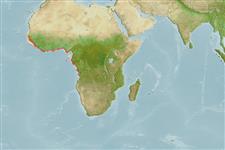>
Carangiformes (Jacks) >
Carangidae (Jacks and pompanos) > Caranginae
Etymology: Hemicaranx: Greek, hemi = the half + French, carangue, the name of a Caribbean fish; 1836 (Ref. 45335).
More on author: Günther.
Environment: milieu / climate zone / depth range / distribution range
Ecologie
marien; brak water demersaal. Tropical
Eastern Atlantic: Along the west African coast from Sierra Leone to Angola (Ref. 57392). Reported from the Sine-Saloum Estuary in Senegal, the Gambia River in Gambia, the Fatala River in Guinea (Ref. 28587) and from Mauritania (Ref. 55783), but this is unconfirmed in Ref. 57392 and needs confirmation.
Grootte / Gewicht / Leeftijd
Maturity: Lm ? range ? - ? cm
Max length : 70.0 cm TL mannelijk / geslacht onbekend; (Ref. 57392); common length : 25.0 cm FL mannelijk / geslacht onbekend; (Ref. 3195)
Dorsale stekels (totaal): 8; Dorsale zachte stralen (totaal): 24-28; Anale stekels 3; Anale zachte stralen: 21 - 24. Diagnosis: body elongate (depth comprised 2.4-3.1 times in fork length) and strongly compressed; eyes small; snout short and rounded; mouth small; end of upper jaw extending to below anterior eye margin; teeth present in jaws, absent on vomer; 1st dorsal fin with 7 spines, 2nd dorsal with 1 spine and 24-28 soft rays; anal fin with 2 detached spines, followed by 1 spine and 21-24 soft rays; scales small and cycloid; breast completely scaleless; lateral line arched over anterior half of pectoral fins, its posterior (straight) part with 41-43 scutes; caudal peduncle very slender, without bilateral keels above and below last lateral line scutes (Ref. 57392).
Coloration: back bluish, sides silvery; black spot on upper margin of gill cover; dorsal- and upper caudal-fin lobes broadly black-edged, other fins light; juveniles with 4-5 dark crossbars on back and sides (Ref. 57392).
Adults are found mainly in coastal areas, entering brackish water (Ref. 2683, 57392). Common mostly in midwater and near bottom (Ref. 7079). Young live in association with medusa (jellyfish) (Ref. 57392).
Levenscyclus en paargedrag
Maturiteit | Voortplanting | Paaien | Eieren | Fecunditeit | Larven
Smith-Vaniz, W.F., J.-C. Quéro and M. Desoutter, 1990. Carangidae. p. 729-755. In J.C. Quero, J.C. Hureau, C. Karrer, A. Post and L. Saldanha (eds.) Check-list of the fishes of the eastern tropical Atlantic (CLOFETA). JNICT, Lisbon; SEI, Paris; and UNESCO, Paris. Vol. 2. (Ref. 7097)
Status op de Rode Lijst van het IUCN (Ref. 130435)
Gevaar voor de mens
Harmless
Gebruik door de mens
Visserij: van minder commercieel belang
Meer informatie
Lokale namenSynoniemenMetabolismePredatorenEcotoxicologieVoortplantingMaturiteitPaaienPaaiaggregatiesFecunditeitEierenOntwikkeling van de eieren
ReferentiesAquacultuurAquacultuurprofielKweeklijnenGeneticaElectrophoresesErfelijkheidZiektesVerwerkingNutrientsMassaconversie
Tools
Speciale rapporten
Download XML
Internetbronnen
Estimates based on models
Preferred temperature (Ref.
123201): 24.4 - 27.9, mean 26.7 °C (based on 62 cells).
Fylogenetische diversiteitsindex (Ref.
82804): PD
50 = 0.5625 [Uniqueness, from 0.5 = low to 2.0 = high].
Bayesian length-weight: a=0.01349 (0.00646 - 0.02815), b=2.96 (2.79 - 3.13), in cm total length, based on LWR estimates for this (Sub)family-body shape (Ref.
93245).
Trofisch niveau (Ref.
69278): 3.9 ±0.6 se; based on size and trophs of closest relatives
Weerstandsvermogen (Ref.
120179): Gemiddeld, minimale populatieverdubbelingstijd 1,4-4,4 jaar (Preliminary K or Fecundity.).
Fishing Vulnerability (Ref.
59153): Moderate to high vulnerability (48 of 100).
Nutrients (Ref.
124155): Calcium = 115 [78, 276] mg/100g; Iron = 1.24 [0.76, 2.35] mg/100g; Protein = 19.3 [18.3, 20.5] %; Omega3 = 0.248 [0.146, 0.435] g/100g; Selenium = 53.5 [29.9, 100.0] μg/100g; VitaminA = 13.3 [4.2, 32.3] μg/100g; Zinc = 1.06 [0.78, 1.46] mg/100g (wet weight);
